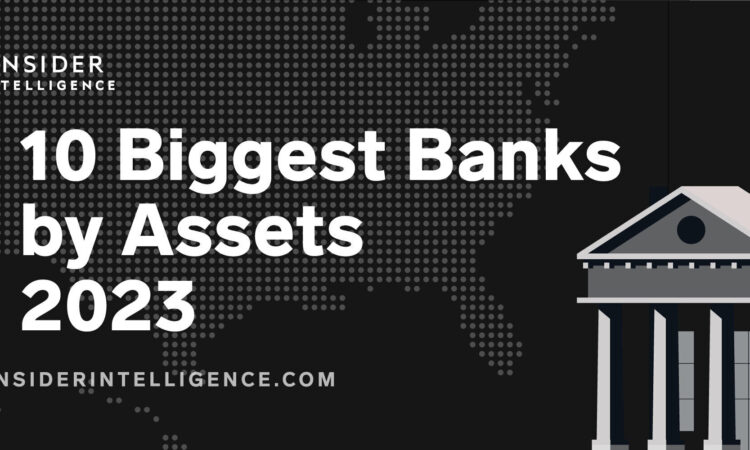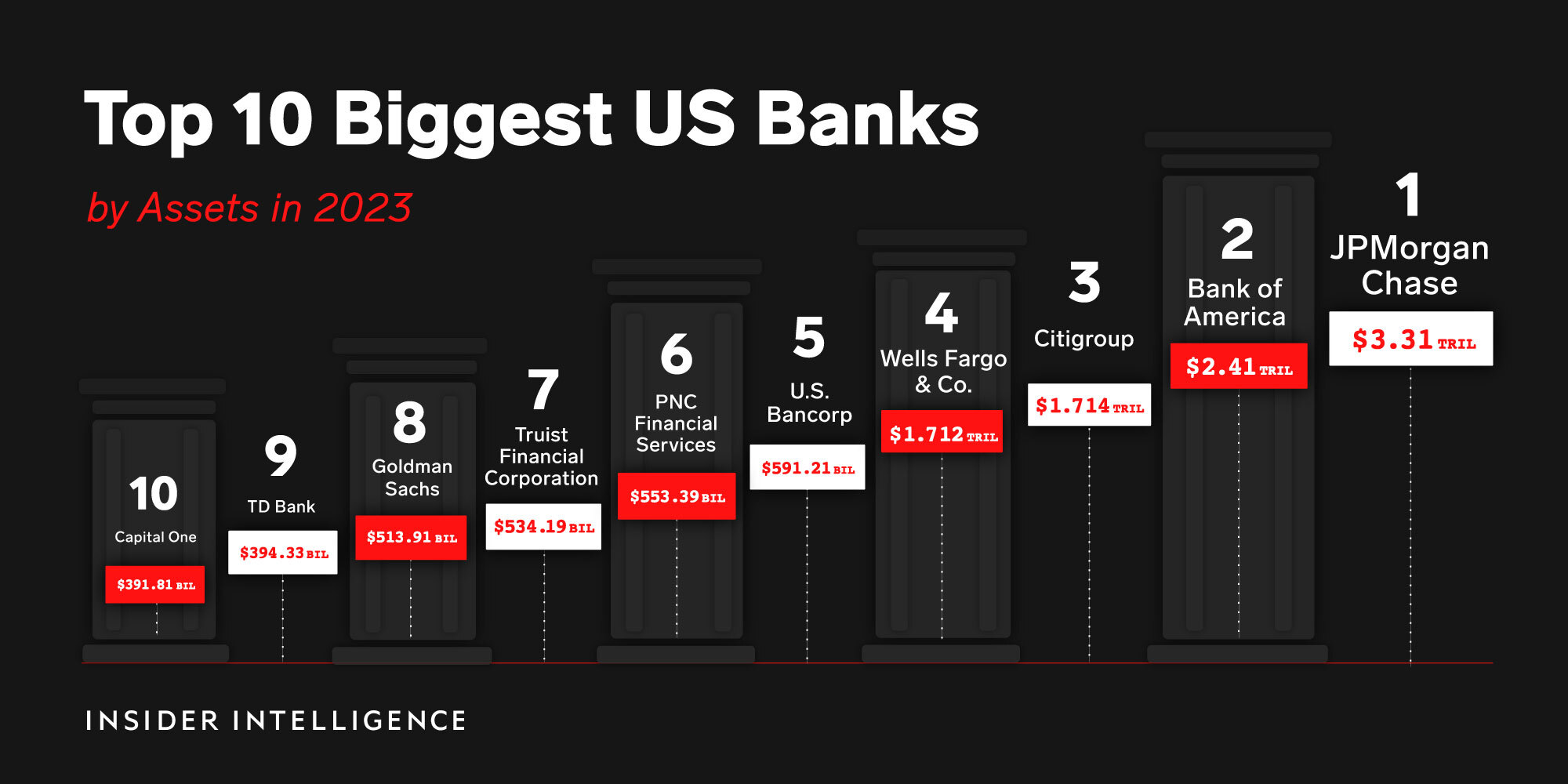
- JPMorgan Chase is the top largest bank in the US, with a balance sheet total of $3.31 trillion.
- Insider Intelligence broke down the top 10 banks in the US by assets, with key insights as to how they got there, where they plan to go in the future, and how smaller banks can compete in the industry.
- Do you work in the Financial Services industry? Get business insights on the latest industry trends, companies, and technologies with data-driven market research & forecasts.
The Federal Reserve has rolled out a list of top US banks by assets, and we’ve broken down exactly how these financial service giants manage to stay ahead of the competition. For decades, banks have been merging, partnering, and expanding—so much so that the top four banks accounted for 50% of all US banking assets last year.
In addition to having more than a trillion dollars in consolidated domestic assets, JPMorgan Chase, Bank of America, Citigroup, and Wells Fargo increased their tech spending to meet the growing demand for efficient mobile banking apps and compete with neobanks and other fintechs.
The incumbents’ shift towards digital strategy gave them an edge among customers—from traditional to early adopters—regardless of their level of comfort with technology. This demonstrates that digital payment options are no longer complementary, but crucial in today’s mobile-first world.
These are the top 10 banks in the US by assets, with key insights as to how they got there, where they plan to go in the future, and how smaller banks can stand out in a competitive industry.

1. JPMorgan Chase – $3.31 Trillion
By targeting digitally-savvy consumers and introducing artificial intelligence (AI) to its offerings, JPMorgan Chase has been able to outperform its competitors. JPMorgan is playing the long-game by acquiring millennials through digital channels—in hopes of eventually converting them to higher-value customers.
Additionally, JPMorgan is investing heavily in banking technology, and had the biggest tech budget of all banks in 2019 with $11.4 billion. A key focus of these funds is identifying use cases to implement AI techniques—such as leveraging voice assistants to enable investment banking clients to access analyst reports and stock exchange information.
In addition to keeping tabs on direct competitors, JP Morgan is also keeping tabs on how companies in other sectors are marketing to clients. “We look across all industries—it may be totally unrelated to financial services,” says Allison Beer. “When we find some delightful customer experience, I’ll screenshot it on my phone and show it to my team as inspiration,” adds Beer.
2. Bank of America – $2.41 Trillion
Bank of America has been able to cut costs and appeal to young users by adapting strategies for the digital age. The bank’s digitized branches–which allow customers to access contactless ATMs and connect with call centers via video-conference technology—accumulated half the traffic of nearby branches only five months after launching in 2017.
Bank of America’s digital-only services have also re-defined what the company offers its customers. Its voice-enabled assistant, Erica, allows customers to make peer-to-peer (P2P) payments as well as bill payments. Since officially launching in 2017, Erica has surpassed 15 million users.
What’s more, digital payments network Zelle, allows users to digitally send real-time payments to friends and family. By integrating this feature into its mobile app, Bank of America has opened the door for increased consumer engagement.
Among the new financial service products to launch this year, Bank of America released a business-to-consumer (B2C) payout solution that gives users greater flexibility with payments; a new credit card meant for business travelers; and a new credit card tied to a cash rewards program.
Like what you’re reading? Click here to learn more about Insider Intelligence’s leading Financial Services research.
3. Citigroup – $1.714 Trillion
For four years in a row, Citibank has been named the “Best Bank for High-Net-Worth Families” by Kiplinger’s Personal Finance. For customers that maintain $200,000 in deposit, retirement, and investment accounts, the bank grants them access to its Citigold Package.
Insider Intelligence’s Mobile Banking Competitive Edge Study also shows that Citi took the top spot for digital money management tools, as rated by consumers. Its in-platform features—including the ability to view recurring charges and see a financial wellness score—helped Citi secure a spot as one of the best banks in the US.
As for the future of growth, it’s all about ensuring “that every product we deliver at Citi is digital first,” says Michael Naggar, chief digital officer of Citibank’s US consumer bank. “Today, digital means taking transactions out of the call center and branch and digitizing them. But our goal is connecting analog and digital so that people can’t see where one ends and the other begins,” adds Naggar.
Now, due to rising interest from its customers, Citigroup is looking into launching crypto services, such as financing, trading, and custody. What’s more, it narrowly beat out Wells Fargo this year, securing the top 3 spot in assets of the big four banks in 2022.
4. Wells Fargo & Co. – $1.712 Trillion
Wells Fargo is following the lead of top competitors by targeting millennials through mobile financial services. Pay with Wells Fargo is a mobile service where users can access their most used payment features before signing into the app. Additionally, Wells Fargo’s app, Greenhouse, helps customers simplify their bills and track spending.
Over the last year, Wells Fargo has been optimizing its business to focus on sectors with strong revenue-generating potential, like credit cards. For example, the financial services firm has a new suite of Visa credit cards, which will directly challenge a joint card from PayPal, Synchrony Financial, as well as Citigroup’s Double Cash, per Bloomberg.
Joining the contactless payment market has also bolstered Wells Fargo’s position as a leading bank. This is not surprising, as 78% of the top 100 US merchants are now accepting contactless transactions and 44% of US consumers prefer contactless payments, per Insider Intelligence research.
5. U.S. Bancorp – $591.21 Billion
U.S. Bancorp, the parent company of U.S. Bank National Association, earned a spot on the list of top US banks, due to its commitment to compete with tech giants making their way into the banking industry.
With Facebook, Amazon, Apple, and Google all announcing their desire to launch financial services, U.S. Bancorp was inspired to improve its own technology. According to Terry Dolan, chief financial officer of U.S. Bancorp, “the bank plans to partner with fintechs in order to maintain competitive banking technology.”
6. PNC Financial Services – $553.39 Billion
PNC Bank stands out as a top US bank, due to its specialized customer perks and original products and services. For example, PNC offers mobile payment options to corporate clients who hold Visa commercial cards—allowing them to leverage popular mobile wallets like Apple Pay.
What’s more, PNC has taken steps to combat fraud, a growing problem in the financial industry and the digital world—including piloted credit cards with card verification values that periodically refresh. While fraudsters may be able to guess three-digit CVV codes relatively easily due to the limited number of permutations, periodically changing CVVs makes stolen data less valuable.
Most recently, PNC responded to the rise in digital banking by rolling out hybrid branches called solution centers—housing self-serve tools such as video teller machines, ATMs, and mobile workstations while in-person staff assist with more complex needs. The hybrid approach is a strong tactic that aligns well with consumer preferences. For example, a 2020 KPMG survey showed that once the pandemic eases, customers would be less likely to visit branches to manage accounts (6%) or check balances (8%).
7. Truist Financial Corporation – $534.19 Billion
Truist is the bank formed by Branch Banking and Trust Company (BB&T) and SunTrust at the end of 2019. According to the Federal Reserve’s 2019 figures, BB&T and SunTrust were ranked 11th and 12th in bank assets, respectively.
Now operating over 2,000 branches in 15 states and Washington, D.C., the combined bank offers consumer and commercial banking, asset management, securities brokerage, mortgage, and insurance products and financial services.
8. Goldman Sachs – $513.91 Billion
A newcomer to the top ten, Goldman Sachs is a well known global investment banking, management and securities firm. Its clients have access to a variety of financial services, including banking products through Marcus—its online banking division that made its debut in fall 2016 and began offering personal loans, per Bankrate.
While its investment banking arm experienced a hit in Q3 of 2022, Goldman saw its consumer and wealth management revenue increase 18% YoY due to credit card balances and higher interest rates. Additionally, its fixed income saw 41% YoY growth—helping Goldman exceed analysts’ estimates. The firm has also announced a full overhaul of its products and services to mitigate its losses in other areas.
9. TD Bank – $394.33 Billion
In addition to having extensive influence abroad, TD Bank has become one of the largest banks in the US due to its integration of artificial intelligence and utilization of digital technology.
TD Bank has partnered with KAI Consumer Banking to launch Clari, an AI-powered chatbot in Canada. Clari answers customers’ questions via text message and notifies them when credit card payments and when a payment is made. As Clari has significantly cut down the call volume in Canada, it is likely that TD Bank may develop a similar chatbot for its US branches.
In another partnership, the company teamed up with fintech provider, Amount, to leverage its suite of digital lending tools—including fraud detection and account verification.
10. Capital One – $391.81 Billion
Capital One has made the list of top US banks, likely due to its ongoing commitment to digital transformation. Capital One increased its technology staff from 2,500 in 2011 to 9,000 in 2019, helping launch Eno—its AI-powered chatbot, similar to Bank of America’s Erica.
Despite its major data breach in mid-2019, the bank also came first on our Banking Digital Trust Report, where it was the frontrunner on all six pillars of trust: security, privacy, reputation, reliability, ease of use, and feature breadth. Capital One’s high scores likely stemmed from its recent large-scale cloud migration, which has improved service continuity, facilitated upgrades, and reinforced security protocols to get back into customers’ good graces.
Capital One also acquired fintech United Income in 2019, a digital platform that offers wealth management services for people transitioning into retirement. This combination allows the firm to offer technological capabilities with human facets. For example, by providing access to a team of wealth managers, this makes Capital One appealing to consumers who still desire human interaction.





